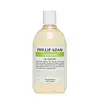What's inside
What's inside
 Key Ingredients
Key Ingredients

 Benefits
Benefits

 Concerns
Concerns

 Ingredients Side-by-side
Ingredients Side-by-side

Water
Skin ConditioningSodium Laureth Sulfate
CleansingSodium Lauryl Sulfate
CleansingCocamidopropyl Betaine
CleansingCocamide Mea
EmulsifyingSodium Benzoate
MaskingCitric Acid
BufferingSodium Chloride
MaskingSalicylic Acid
MaskingMentha Arvensis Leaf Oil
MaskingMentha Piperita Oil
MaskingTetrasodium EDTA
Methylparaben
PreservativePropylene Glycol
HumectantGlycerin
HumectantSodium Hydroxide
BufferingLimonene
PerfumingCamellia Sinensis Leaf Extract
AntimicrobialCystine Bis-Pg-Propyl Silanetriol
Skin ConditioningNiacinamide
SmoothingPanthenol
Skin ConditioningBiotin
AntiseborrhoeicLecithin
EmollientTocopheryl Acetate
AntioxidantCitrus Paradisi Peel Extract
PerfumingHumulus Lupulus Extract
AntimicrobialUrtica Dioica Leaf Extract
Skin ConditioningCI 42090
Cosmetic ColorantAcer Saccharum Extract
Skin ConditioningCitrus Limon Peel Extract
EmollientSaccharum Officinarum Extract
MoisturisingVaccinium Myrtillus Leaf Extract
AstringentFaex Extract
Skin ConditioningPropylparaben
PreservativePhenoxyethanol
PreservativeCitrus Aurantium Dulcis Fruit Extract
MaskingPotassium Sorbate
PreservativeMaltodextrin
AbsorbentSodium Citrate
BufferingEthylparaben
PreservativeButylparaben
MaskingSodium Xylenesulfonate
Water, Sodium Laureth Sulfate, Sodium Lauryl Sulfate, Cocamidopropyl Betaine, Cocamide Mea, Sodium Benzoate, Citric Acid, Sodium Chloride, Salicylic Acid, Mentha Arvensis Leaf Oil, Mentha Piperita Oil, Tetrasodium EDTA, Methylparaben, Propylene Glycol, Glycerin, Sodium Hydroxide, Limonene, Camellia Sinensis Leaf Extract, Cystine Bis-Pg-Propyl Silanetriol, Niacinamide, Panthenol, Biotin, Lecithin, Tocopheryl Acetate, Citrus Paradisi Peel Extract, Humulus Lupulus Extract, Urtica Dioica Leaf Extract, CI 42090, Acer Saccharum Extract, Citrus Limon Peel Extract, Saccharum Officinarum Extract, Vaccinium Myrtillus Leaf Extract, Faex Extract, Propylparaben, Phenoxyethanol, Citrus Aurantium Dulcis Fruit Extract, Potassium Sorbate, Maltodextrin, Sodium Citrate, Ethylparaben, Butylparaben, Sodium Xylenesulfonate
Water
Skin ConditioningAmmonium Cocoyl Isethionate
CleansingCocamidopropyl Betaine
CleansingDecyl Glucoside
CleansingHydrolyzed Pea Protein
EmollientLactic Acid
BufferingGuar Hydroxypropyltrimonium Chloride
Skin ConditioningGlycerin
HumectantCaprylhydroxamic Acid
Caprylyl Glycol
EmollientMentha Piperita Oil
MaskingEucalyptus Globulus Oil
Chamomilla Recutita Flower Extract
MaskingMelissa Officinalis Leaf Extract
Skin ConditioningUrtica Dioica Extract
AstringentRosmarinus Officinalis Leaf Extract
AntimicrobialSalvia Officinalis Extract
AntimicrobialWater, Ammonium Cocoyl Isethionate, Cocamidopropyl Betaine, Decyl Glucoside, Hydrolyzed Pea Protein, Lactic Acid, Guar Hydroxypropyltrimonium Chloride, Glycerin, Caprylhydroxamic Acid, Caprylyl Glycol, Mentha Piperita Oil, Eucalyptus Globulus Oil, Chamomilla Recutita Flower Extract, Melissa Officinalis Leaf Extract, Urtica Dioica Extract, Rosmarinus Officinalis Leaf Extract, Salvia Officinalis Extract
 Reviews
Reviews

Ingredients Explained
These ingredients are found in both products.
Ingredients higher up in an ingredient list are typically present in a larger amount.
Cocamidopropyl Betaine is a fatty acid created by mixing similar compounds in coconut oil and dimethylaminopropylamine, a compound with two amino groups.
This ingredient is a surfactant and cleanser. It helps gather the dirt, pollutants, and other impurities in your skin to be washed away. It also helps thicken a product and make the texture more creamy.
Being created from coconut oil means Cocamidopropyl Betaine is hydrating for the skin.
While Cocamidopropyl Betaine was believed to be an allergen, a study from 2012 disproved this. It found two compounds in unpure Cocamidopropyl Betaine to be the irritants: aminoamide and 3-dimethylaminopropylamine. High-grade and pure Cocamidopropyl Betaine did not induce allergic reactions during this study.
Learn more about Cocamidopropyl BetaineGlycerin is already naturally found in your skin. It helps moisturize and protect your skin.
A study from 2016 found glycerin to be more effective as a humectant than AHAs and hyaluronic acid.
As a humectant, it helps the skin stay hydrated by pulling moisture to your skin. The low molecular weight of glycerin allows it to pull moisture into the deeper layers of your skin.
Hydrated skin improves your skin barrier; Your skin barrier helps protect against irritants and bacteria.
Glycerin has also been found to have antimicrobial and antiviral properties. Due to these properties, glycerin is often used in wound and burn treatments.
In cosmetics, glycerin is usually derived from plants such as soybean or palm. However, it can also be sourced from animals, such as tallow or animal fat.
This ingredient is organic, colorless, odorless, and non-toxic.
Glycerin is the name for this ingredient in American English. British English uses Glycerol/Glycerine.
Learn more about GlycerinMentha Piperita Oil is the volatile oil obtained from the whole plant of the Peppermint plant.
It can be used to add a fresh scent to products.
Peppermint oil may cause skin sensitivity and redness due to its menthol content. Menthol also has a cooling effect (like your toothpaste).
Learn more about Mentha Piperita OilWater. It's the most common cosmetic ingredient of all. You'll usually see it at the top of ingredient lists, meaning that it makes up the largest part of the product.
So why is it so popular? Water most often acts as a solvent - this means that it helps dissolve other ingredients into the formulation.
You'll also recognize water as that liquid we all need to stay alive. If you see this, drink a glass of water. Stay hydrated!
Learn more about Water